Chapter 2
Banks' adjustment of home loan interest rates
The official rate and banks' cost of funding
2.1
In recent years, banks have tended to move the interest rate charged on
their variable home loans closely in line with movements in the Reserve Bank's
official target overnight 'cash' rate (see Chart 2.1, the thick line in Chart 2.2
and the left hand half of Chart 2.3). This has led to an expectation developing
that this is the 'usual' or 'fair' way of setting home loan interest rates.
2.2
However, the Reserve Bank recently observed:
...while the cash rate still has a large influence on banks’
funding costs, changes in risk premia in markets over the past two years have
weakened this relationship. In turn, this has also weakened the close
relationship that has been experienced in the previous decade between the cash
rate and banks’ interest rates on loans.[1]
Chart 2.1
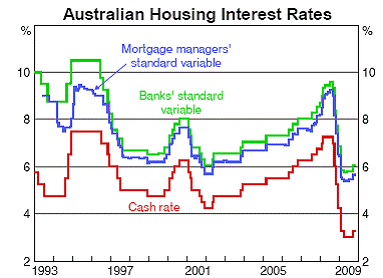
Source: Reserve Bank of Australia, www.rba.gov.au
Chart 2.2:
Difference between home loan variable interest rate and other rates
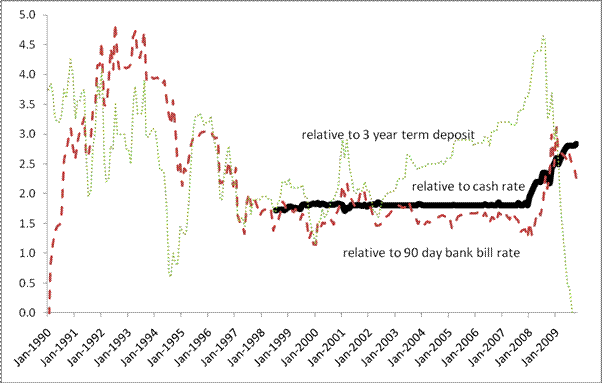
Source:
Secretariat, based on data from Reserve Bank of Australia, www.rba.gov.au
Chart 2.3: NAB's
standard variable mortgage rate, funding costs and cash rate
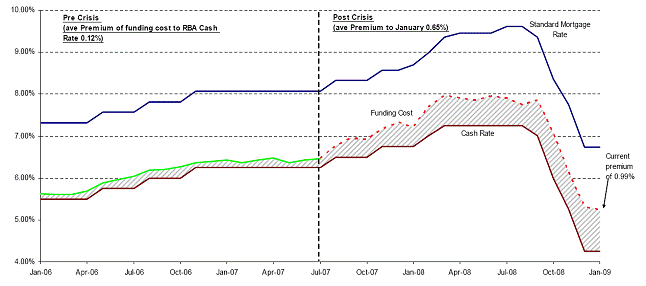
Source:
National Australia Bank, Submission 5, attachment 2.
2.3
The recent breakdown in the relationship between the variable home loan
interest rate and the cash rate is shown in Charts 2.2 and 2.3.
2.4
Rather than the norm, the close relationship between the cash rate and
lending rates had been an unusual feature of the 2000s:
The relationship between the cash rate and the rate on
standard housing loans was particularly close from 1999 to 2007, though in the
longer sweep of history this period looks unusual.[2]
The presumption that their lending rates would and should
move only in line with the cash rate, which had arisen in an earlier period
when all these rates were much more closely related, has not been a realistic
one in the recent environment.[3]
2.5
Chart 2.2 shows that while the home loan interest rate is currently
higher than usual when compared to the cash rate, it is around its long-term
average when compared to the 90 day bank bill rate and is currently very low
compared to term deposit rates.
2.6
A number of lenders made the point that the interest rate paid on a
significant proportion of funds raised by lenders does not move with the
official cash rate and so it is not reasonable to expect lending rates to move
in line with the official cash rate:
The fact is that roughly half of the money that banks borrow
to lend to people here in Australia is sourced from outside depositors. It is
sourced from the wholesale markets both here in Australia and overseas; it is
sourced both long term and short term. That means, as I said before, that the
cash rate has little if any effect on the costs that banks have to pay to source
their money to lend to people.[4]
There are really three factors that we take into account when
determining the mortgage rate. They are the actual cost of our funds, the risk
that we perceive in the environment we are lending into and also, obviously, we
are looking at remaining competitive with other providers of credit. The main
factor within that would be the cost of funds, and that in itself is broken
down into three areas. About half of our funding, like most major banks in
Australia, comes from depositors; about half of the remaining 50 per cent comes
from short-term wholesale funding; and the final 25 per cent comes from
long-term wholesale funding.[5]
Mortgage rates are determined by the cost of funds to
institutions – that is, the cost of raising funds through either retail
deposits or wholesale funds. The cost of these funds has no direct link to the
RBA cash rate.[6]
The current Bill attempts to bring back a system of setting
rates that were inefficient and do not reflect how funds are raised and costed
today... The big four do not rely on the RBA cash rate; the international market
governs the costs of funds.[7]
2.7
As an example, the ANZ comments that over half their funding comes from
customer deposits (Chart 2.4), and that the cost of these has not dropped
commensurately with the official cash rate:
...the cost of deposits has fallen more slowly than the cash
rate over the past year. This reflects the current strong competition between
financial institutions for deposits. Since early September 2008, rates on
savings deposits have fallen by an average of 380 basis points, less than the
425 basis point decrease in the official cash rate.[8]
Chart 2.4:
Composition of ANZ's funding (March 2009)
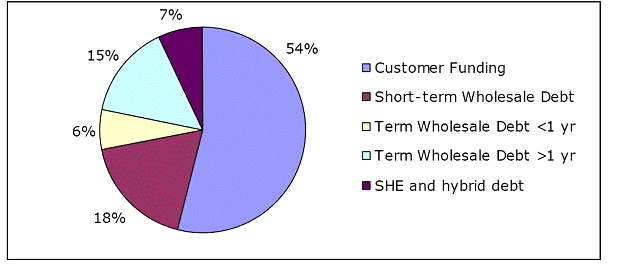
Source: ANZ Bank, Submission
4, p 4.
2.8
The Reserve Bank have compiled data showing only around a quarter of
banks' funding is priced directly off the official cash rate (Table 2.1).
Table 2.1: Major
banks' funding mix (as at April 2009)
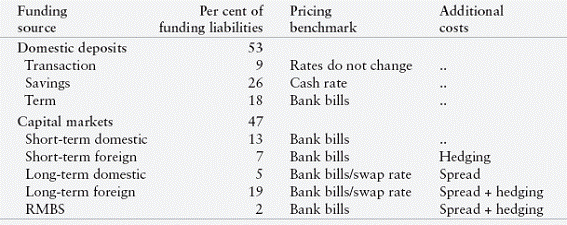
Source:
Reserve Bank of Australia, 'The impact of the capital market turbulence on
banks' funding costs', Reserve Bank Bulletin, June 2009, p 3.
2.9
NAB added about the use of foreign funding:
Structurally, it is true that Australians are borrowing more
than they save. Hence, the National Bank is reasonably typical in only being
able to obtain half the money we wish to loan from the depositors in the bank.[9]
2.10
Looking at the recent period, the Reserve Bank observe:
It is estimated that the major banks have reduced their
variable housing lending rate by an average of 385 basis points since September 2008.
This is less than the reduction in the cash rate of 425 basis points, but
more than the reduction in their average funding costs of 330 basis
points.[10]
Competition and bank margins
2.11
Calls for a degree of re-regulation of bank loan interest rates have
been fuelled by concerns that there is reduced competitive pressure on banks.
For example, former ACCC head Allan Fels has commented:
We are now back to where we were in the 1970s and I fear a
similar prolonged period of limited competition...[11]
2.12
Bank margins narrowed as competition (most notably from non-bank home
lenders such as Aussie, RAMS and Wizard) increased over the past decade (Charts 2.1
and 2.5).[12]
More recently, the global financial crisis has seen a drying up of the
securitisation markets used by the competitors to banks and a reduction in the
competitive pressure exerted by these non-bank lenders. There has also been
some consolidation within the banking industry.[13]
The combined effect has been that the four major banks have gone from accounting
for around 60 per cent of new home loans in 2007 to approaching 90 per cent
now.
2.13
There has been an expansion in bank margins recently (Chart 2.5).[14]
However, as noted above it has been in their loans to business rather than
households that the expansion in margins has occurred.
Chart 2.5: Major
banks' net interest margin
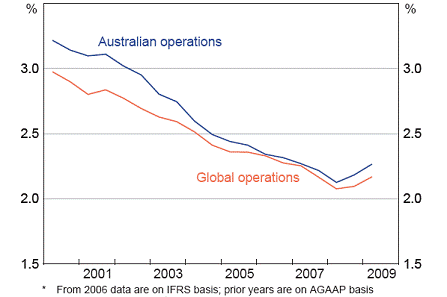
Source:
Reserve Bank of Australia, 'The impact of the capital market turbulence on
banks' funding costs', Reserve Bank Bulletin, June 2009, p 11.
Accountability and transparency
2.14
National Australia Bank's submission emphasises their efforts to explain
the relationship between their cost of funds and lending rates:
With each adjustment in our variable mortgage interest rate
NAB has publicised and made widely available detailed information on our
over-all funding costs and how these have impacted our decisions on rates.[15]
2.15
At the hearing they reiterated their support for transparency:
NAB supports the need for greater transparency around the
commercial setting of interest rates. We believe that NAB customers and the
wider community should hear directly from us about the factors that influence
their home loan repayments...We also believe that better public information and
understanding of the full range of factors affecting commercial interest rates
is in the interests of all stakeholders: customers, the media, government and
the banks themselves.[16]
2.16
They explained the measures they were taking:
Since August last year, National Australia Bank has provided
detailed information on funding costs to our customers, the media and other
stakeholders. This means that each time the NAB has adjusted its variable
mortgage rate we have made available details of how our overall funding costs
have impacted our decision. [17]
2.17
Critics of the banks may always be sceptical of information provided by
them. This has led to calls for independent authorities to publish information
as well:
Senator PRATT—... who has the most substantive body of
knowledge that compares what is going on with both official interest rates and
what banks are actually doing?
Prof. Sathye—I would say that APRA and the Reserve Bank of
Australia are the best organisations to do that kind of research and get that
kind of information...I would like that kind of information [on interest rate
margins] to be generated by these agencies and put forward to people.[18]
We would also like to suggest that the RBA itself continue to
play a role in increasing information and education on the factors affecting
interest rates, as it did with its analysis published in its June bulletin on
the costs of funds...We believe that more of this type of information from the
RBA would make a significant and positive contribution to public transparency
and understanding of the factors affecting interest rates.[19]
Committee view
2.18
The committee regards it as helpful for the public debate for banks to explain
the relationship between the official cash rate, their own cost of funds and
the rates they charge on loans, especially for variable rate housing loans. It
commends those banks which do so.
2.19
It would further enable informed opinions to be made around this issue
if the relevant authorities made more data available.
Recommendation 1
2.20 The committee recommends that the Reserve Bank and the Australian
Prudential Regulation Authority regularly publish estimates of the costs of
funds for the banking sector as a whole and bank interest margins.
Navigation: Previous Page | Contents | Next Page